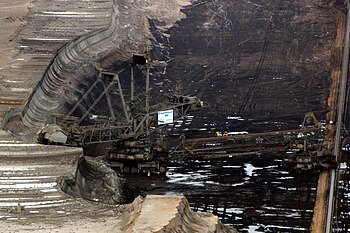|
Type SRs 8000 bucket-wheel excavator
The Type SRs 8000 or less commonly known as the SRs 8000-class,[6] is a family of bucket-wheel excavators known for being one of the largest terrestrial vehicles ever made by man, with Bagger 293 its - "lead vessel" - being the largest ground vehicle in history.[7] The Type SRs 8000 classification was coined by TAKRAF to describe specifically, Bagger 293, although it is unclear if this extends to its other "sibling vehicles" within the same bulk.[8] Whilst the "Bagger" family may indicate a copy/series of the same vehicle type, it is more of a loose denominator to group any BWEs of similar bulk, length, height and size within the Hambach surface mine.[9][10] Indeed, some of the Baggers created aren't of the same size, construction period or even in the same built manufacturer. Bagger 293 and 288 for example, was constructed by TAKRAF and Krupp respectively.[11][12][13] SpecificationsAs aforementioned, the one factor that unites all of them are their size. All members of the Type SRs 8000 weigh at the bare minimum of over 7,000 tons. The smallest and oldest of the family, Bagger 281 (built in 1958[2][3]) weigh over 7,800 tons, although the average weight range is around 13,000 tons.[10] Likewise, all members reach lengths of over 200 meters and require a small crew of five.[14][8] Such a size would mean that these vehicles would have its own on-board toiletry and kitchenette rooms.[15] As BWEs, the Type SRs 8000s are all externally powered by a nearby coal production plant with an internal 6,413 kW (8,600 hp) powered electric motor to keep the machine operating smoothly. On average, all Baggers require a total output 16.56 MW (22,207 hp) of power to function with all-systems running.[5][4] Their primary goal as BWEs, is in excavating lignite coal in Germany for processing to be turned into energy or 240,000 cubic metres of overburden daily.[16][17] Currently, all Type SRs 8000s are in-service. They are Bagger 281 (1958), Bagger 285 (1975), Bagger 287 (1976), Bagger 288 (1978), Bagger 291 (1993) and Bagger 293 (1995).[9] Gallery
See alsoReferences
|
||||||||||||||||||||||||||||||||||||||||||
Portal di Ensiklopedia Dunia





